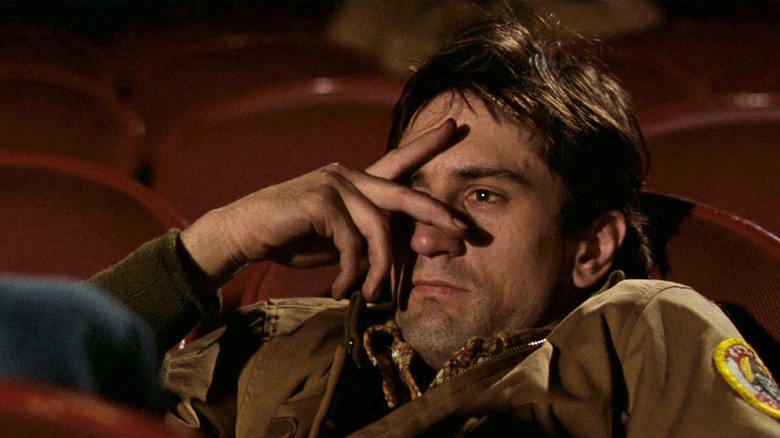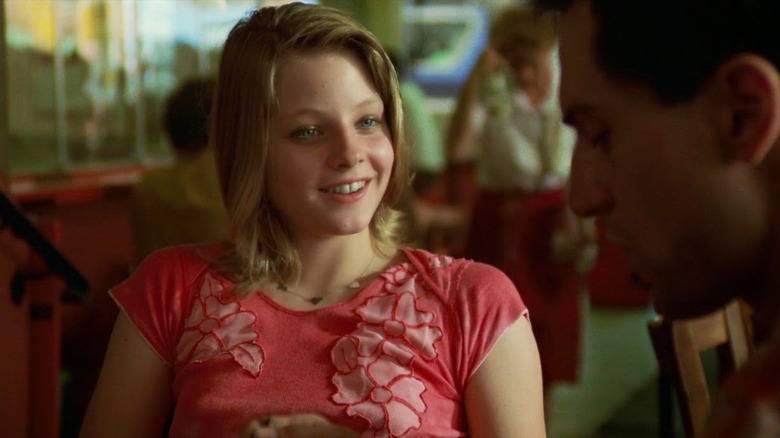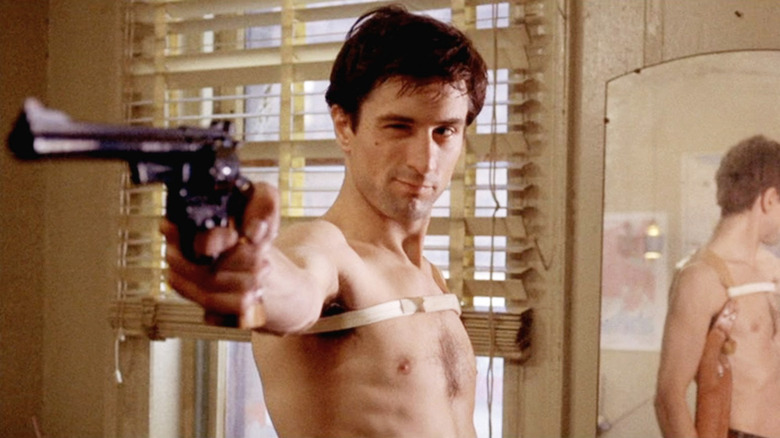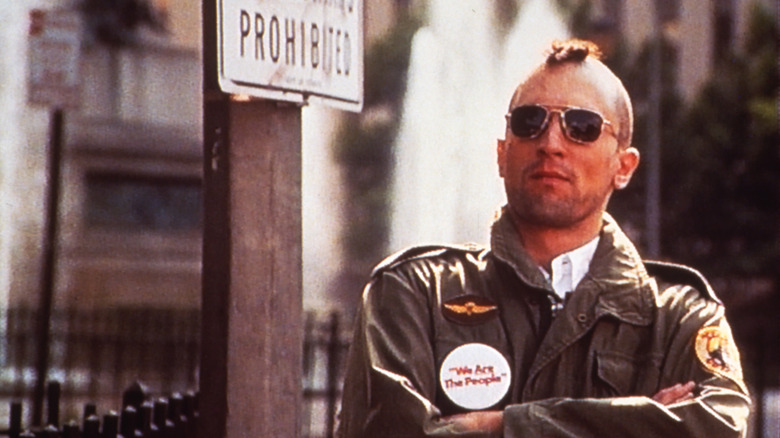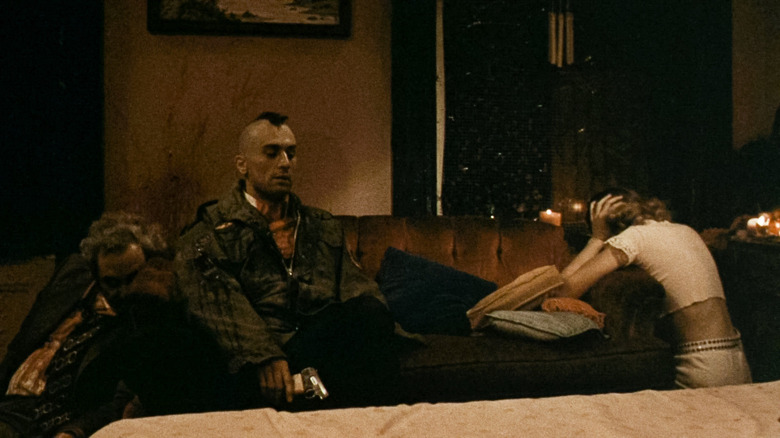Making Taxi Driver Rated R Was A Struggle For Martin Scorsese
Back in the '70s, the notorious X certificate could help a movie reach an unexpected new audience. "Pink Flamingos" became a cult classic, with the hip and the curious flocking to midnight screenings to see what all the fuss was about for themselves, while "Deep Throat" crossed over into the mainstream and launched the "porno chic" era, where regular upstanding citizens went to watch hardcore smut in theaters. One of many celebrities who admitted to watching "Deep Throat" during this fashionable boom in explicit material was Martin Scorsese, who quickly found that earning the naughty X certificate was more likely to scupper his artistic vision than promote it.
Paul Schrader's scathing "Taxi Driver" script, written while the screenwriter was broke and living out of his car, found its way to Scorsese after he'd made his second feature, "Boxcar Bertha." Columbia Pictures had bought the rights, but weren't completely sold on him directing the picture until he proved his talent further. "Mean Streets" changed that, helped along by Robert De Niro's unpredictable turn as hothead Johnny Boy.
By the time "Taxi Driver" went into production, shooting on location in New York, De Niro was an Oscar winner for his performance in "The Godfather: Part II" and Scorsese further enhanced his credentials with "Alice Doesn't Live Here Anymore," which earned Ellen Burstyn an Academy Award for Best Actress. The table was set for a modern classic, one of the great '70s New York movies alongside "Dog Day Afternoon" and "The Warriors," to name but two.
Scorsese's relationship with Columbia became a little rocky during the shoot, so they weren't exactly thrilled when his descent into urban alienation landed the dreaded X certificate.
So what happens in Taxi Driver again?
Travis Bickle (De Niro) is a lonely Vietnam vet adrift in New York. Suffering from insomnia, he whiles away his nights in porno theaters before taking a job as a cabbie. Prowling Manhattan looking for fares, he views humanity with disgust, yearning for the day when "a real rain will come and wash all this scum off the streets."
Alienated and angry, Bickle has a brief brush with normality when he intrigues a smart young campaign volunteer, Betsy (Cybil Shepherd). Their first date ends in excruciating weirdness when he takes her to one of his grotty hardcore porn cinemas. Becoming increasingly isolated, he half-heartedly plans to assassinate the presidential candidate Betsy works for, before casting himself as guardian angel to 12-year-old sex worker, Iris (Jodie Forster). When his halting attempt to kill the politician is thwarted, he bloodily rescues Iris instead, becoming a media hero.
Scorsese's film is a lurid pavement-level vision of an urban hell, putting us in Bickle's headspace for much of the film. The disturbing finale prefigures reality TV culture where even a nobody as unhinged as our antihero can get his 15 minutes of fame, a topic the director covered even more prophetically in "The King of Comedy" several years later. That idea was not without precedent; Schrader was partly inspired by Lynette "Squeaky" Fromme, the Manson Family acolyte whose assassination attempt on Gerald Ford got her on the cover of Newsweek. Disturbingly, John Hinckley Jr., who would later make an attempt on Ronald Reagan's life, was obsessed with "Taxi Driver" and stalked Jodie Foster before trying to gun down the president (via Washington Post).
Why was the X certificate bad for studio pictures?
The Motion Picture Association of America (MPAA) introduced the X rating in 1968 to indicate that a film was not for kids due to graphic sex, violence, and bad language. The rating wasn't necessarily a commercial kiss of death at first: "Midnight Cowboy" carried the certificate but still won the Best Picture Oscar.
The certificate took on other connotations in the '70s when pornographic filmmakers started using it to emphasize the adult content of their movies. Anyone could willingly apply the X certificate to their films because it wasn't copyrighted, and pornographers didn't stop there. Next came XX- and XXX-rated movies, which became linked with softcore and hardcore porn respectively.
While neither of the extra X's were ever officially recognized by the MPAA, their salacious existence still had a knock-on effect to the prospects of legitimate films bearing the more modest X certificate. Due to the association with pornography, fewer theaters would book X-rated films and some newspapers refused to carry adverts for them. As a result, producers and directors often found themselves trimming offending scenes to appease the censors. "Robocop" needed no less than 11 edits before it could receive the far less scandalous R certificate.
The MPAA tried to fix the problem in 1990 when they introduced and copyrighted the NC-17 certificate (No Children Under 17 Admitted), but the stigma of the highest-strength rating still causes headaches for filmmakers three decades later (via The Guardian). It is still widely regarded as box office poison, while many legitimate filmmakers — including Scorsese with "The Wolf of Wall Street" — cut their films for them to have any chance at the Oscars.
Nowadays, the X certificate is even more synonymous with porn, which makes searching for images for Vin Diesel's "XXX" a very NSFW activity.
What was it about Taxi Driver that potentially warranted the X certificate?
The main sticking point for the censors with "Taxi Driver" was the climactic shootout where Bickle misguidedly goes to rescue Iris, cold-bloodedly shooting her pimp in the street before wading into a brothel and murdering two more scumbags before trying to take his own life. The scene is pretty disturbing even today, with gore-slicked walls and people graphically getting their fingers blown off. What makes it so impactful is how grubby and matter-of-fact it all is. There are no histrionics as Bickle mechanically goes into killer mode and lays waste to everyone between him and Iris, taking some serious injuries along the way.
The scene is set up by a preceding 90 minutes of menacing atmosphere, with Michael Chapman's lurid camera work framing Bickle as a predator stalking a low-rent world, and Bernard Hermann's jazzy score oscillating between horror motifs and a seedy romance theme that could come straight from a '70s softcore porno. The shootout itself is perhaps more shocking because very little violence comes before. We obviously know there is something very off about Bickle but there are times when he comes across as almost personable. He's not a raving lunatic so it's scary when he switches into Terminator mode, bathed in hellish red.
It was all a bit too much for the MPAA, who gave the first cut the dreaded X. Scorsese and his team were hit with an ultimatum by the studio: cut it, or we'll cut it for you (via Hollywood Reporter).
How Scorsese avoided the X certificate
"Taxi Driver" went through several more edits trying to tone down the offending gore, during which time Scorsese was wooed by rival studio United Artists to take the film "sight unseen with an X." It was a tempting offer, but with a potential for legal issues, so the director persevered.
He finally made the breakthrough with the MPAA when he trimmed some of the bloodiest scenes and took inspiration from John Huston's "Moby Dick," desaturating the color to make the final shootout more grainy and less gory. It was a decision that Scorsese was eventually very pleased with, to the point he later decided to keep the grain on the Columbia logo at the start of the picture. That stylistic choice made total sense for this grittiest of gritty '70s New York movies.
The studio still had little confidence in the final product, only screening it in two theaters initially, but it went onto become a box office success and earn four Oscar nominations for Best Picture, Actor (De Niro), Supporting Actress (Foster), and Original Score (Hermann, who died a few months before the film came out). "Taxi Driver" cemented Scorsese's reputation as one of America's hottest young directors and became one of the touchstones of the New Hollywood era of outstanding filmmaking.
It has also entered our collective pop-conscious thanks to De Niro's ad-libbed "You talkin' to me?" scene; I don't think my other half has even seen the film but I've still heard her use the line. You can't say that about "Pink Flamingos" or "Deep Throat."
